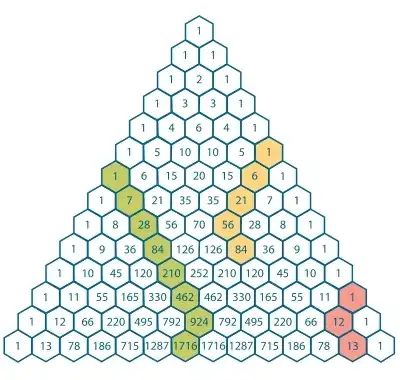I am currently doing a little self study on difference sequences and they use the following identity $$\sum_{k=0}^n \binom{k}{p}= \binom{n+1}{p+1}$$ I have never seen this identity without proof as if it is obvious, am I missing something is this an obvious result that perhaps is a consequence of some other theorem, if not could someone provide some intuition as to why this identity is true or even a proof. Any help is appreciated, thanks in advance.
-
There is a restriction: $k\geq p$. In this case, the formula is $$\sum_{k=p}^n \binom{k}{p}= \binom{n+1}{p+1}$$ – DiegoMath Dec 22 '16 at 22:52
-
2@DiegoMath Usually $\binom{k}{p}$ is just defined to be $0$ for $k<p$, so there is no problem adding these terms – TomGrubb Dec 22 '16 at 22:53
-
@bburGsamohT Thanks for remember that! – DiegoMath Dec 22 '16 at 22:53
2 Answers
It is more or less famously known as the hockey-stick identity. If you recall Pascal's triangle, notice that each number is the sum of the two above. Now take the orange number $84$ below. It is the sum of the two above it: $84=56+28$. Similarly, $28$ is the sum of the two numbers above it, and then the sum above it etc. so that we end up with
$$\sum_{k=0}^3\binom k6=\binom47$$
which more or less uses the definition of the binomial coefficient through Pascal's triangle.
If this is not so obvious, an induction proof isn't too hard:
$$\sum_{k=0}^{n+1}\binom kp=\binom{n+1}p+\sum_{k=0}^n\binom kp=\binom{n+1}p+\binom{n+1}{p+1}=\binom{n+2}{p+1}$$
The last step was the sum of two binomials equalling the next below it.
It is then clear that this holds for $n=1$ reqardless of $p$.
- 74,685
One way to prove this is using induction and the identity $\binom{n}{k}=\binom{n-1}{k}+\binom{n-1}{k-1}$. Here is a direct combinatorial approach:
$\binom{n+1}{p+1}$ directly counts the number of ways of selecting a set of $p+1$ numbers from $\{1,2,3,\dots,n+1\}$
Alternatively, assume we had a set of $p+1$ elements. Then it has a maximal element, say $x$. Once we choose $x$, we then choose the remaining $p$ elements from the set $\{1,2,\dots,x-1\}$, for a total of $\binom{x-1}{p}$ ways. Summing over the possible maximum values gives the left hand side $\sum_{x=p+1}^{n+1}\binom{x-1}{p}$, after which you can finish with a simple change of variables.
- 12,909
-
1@SimpleArt Your argument is the inductive one, it does not seem combinatorial to me. If you think about it, you are inductively applying the identity first to $84$, then to $28$, etc. – TomGrubb Dec 22 '16 at 23:05
-
1
